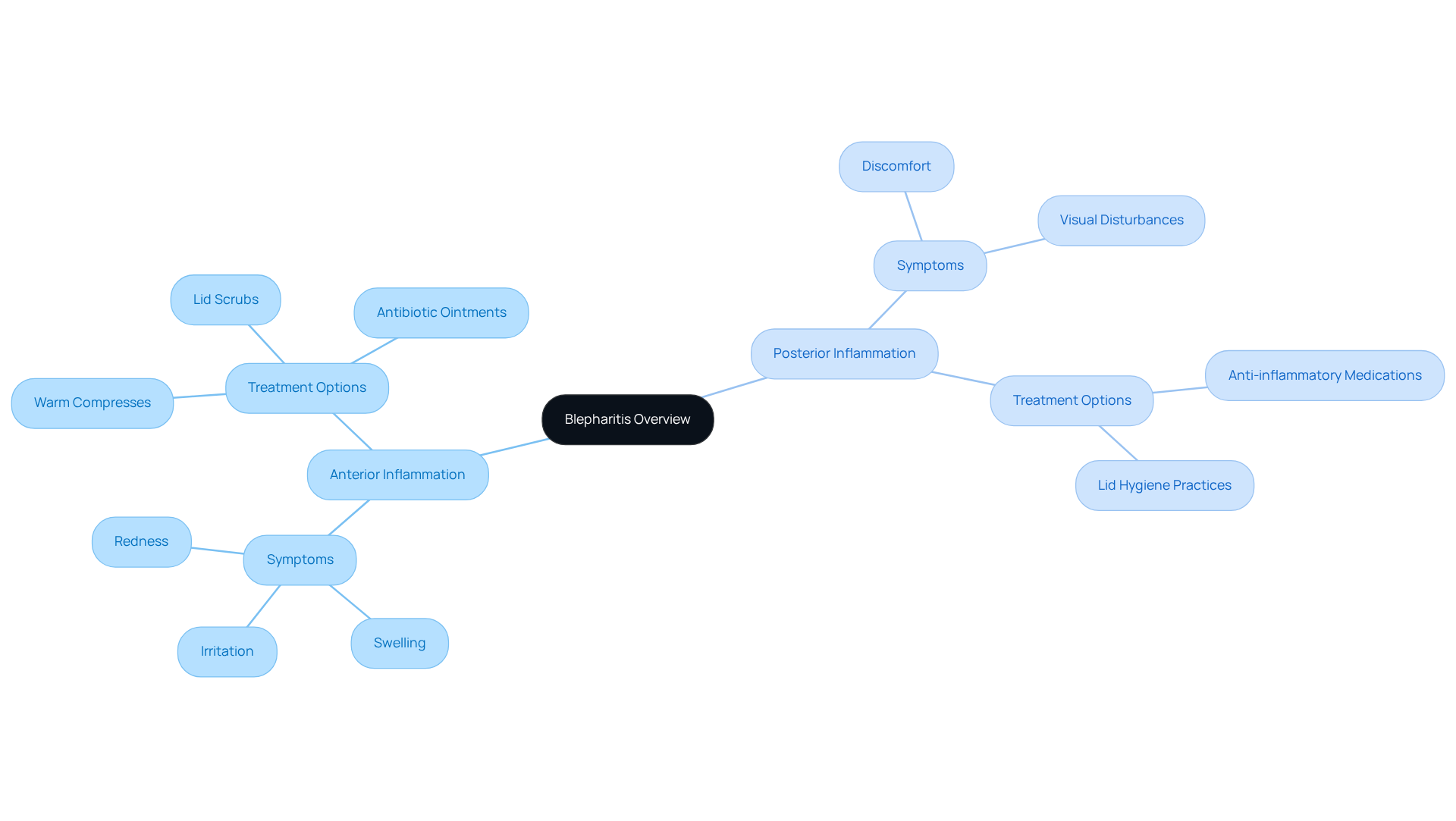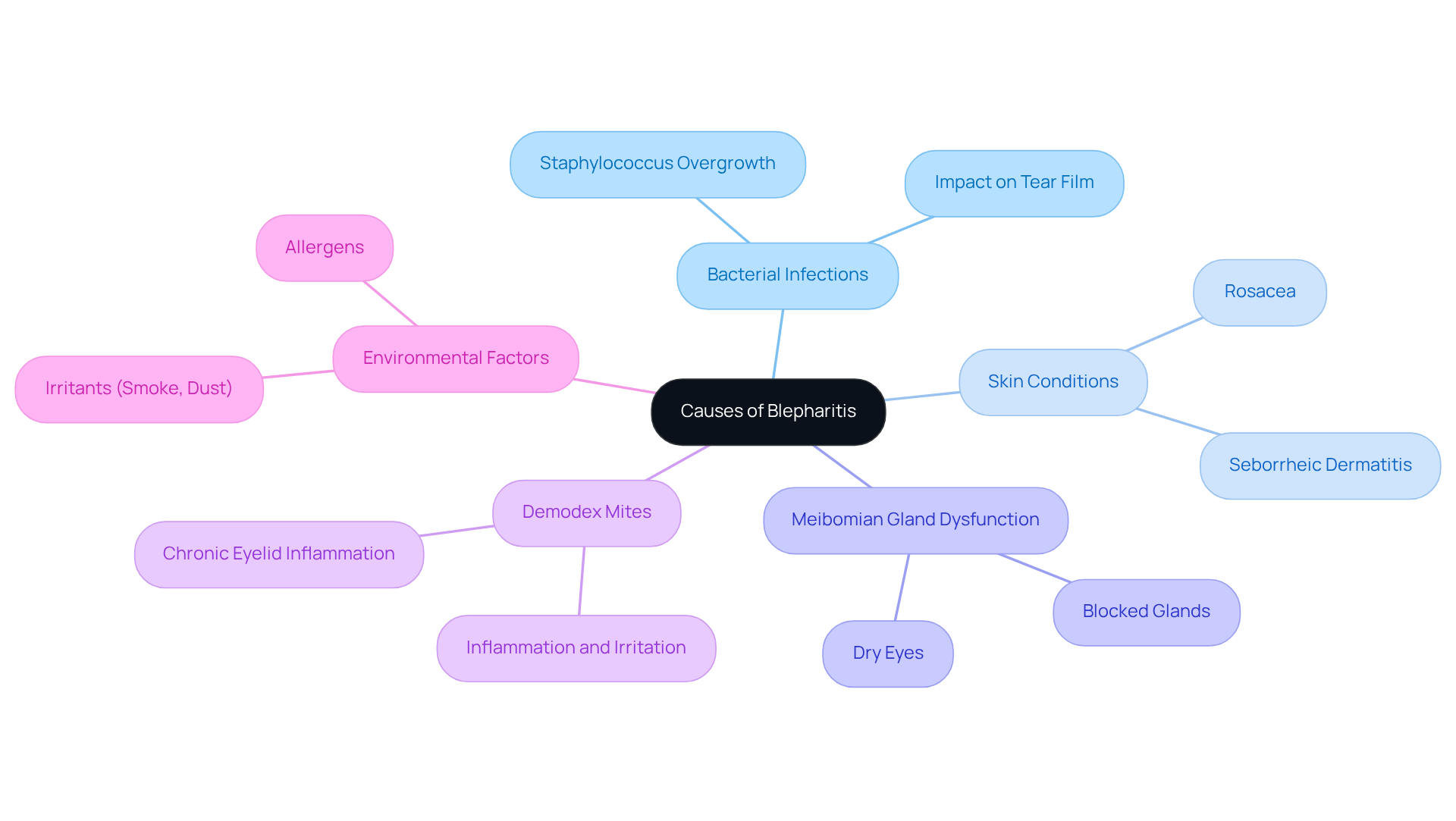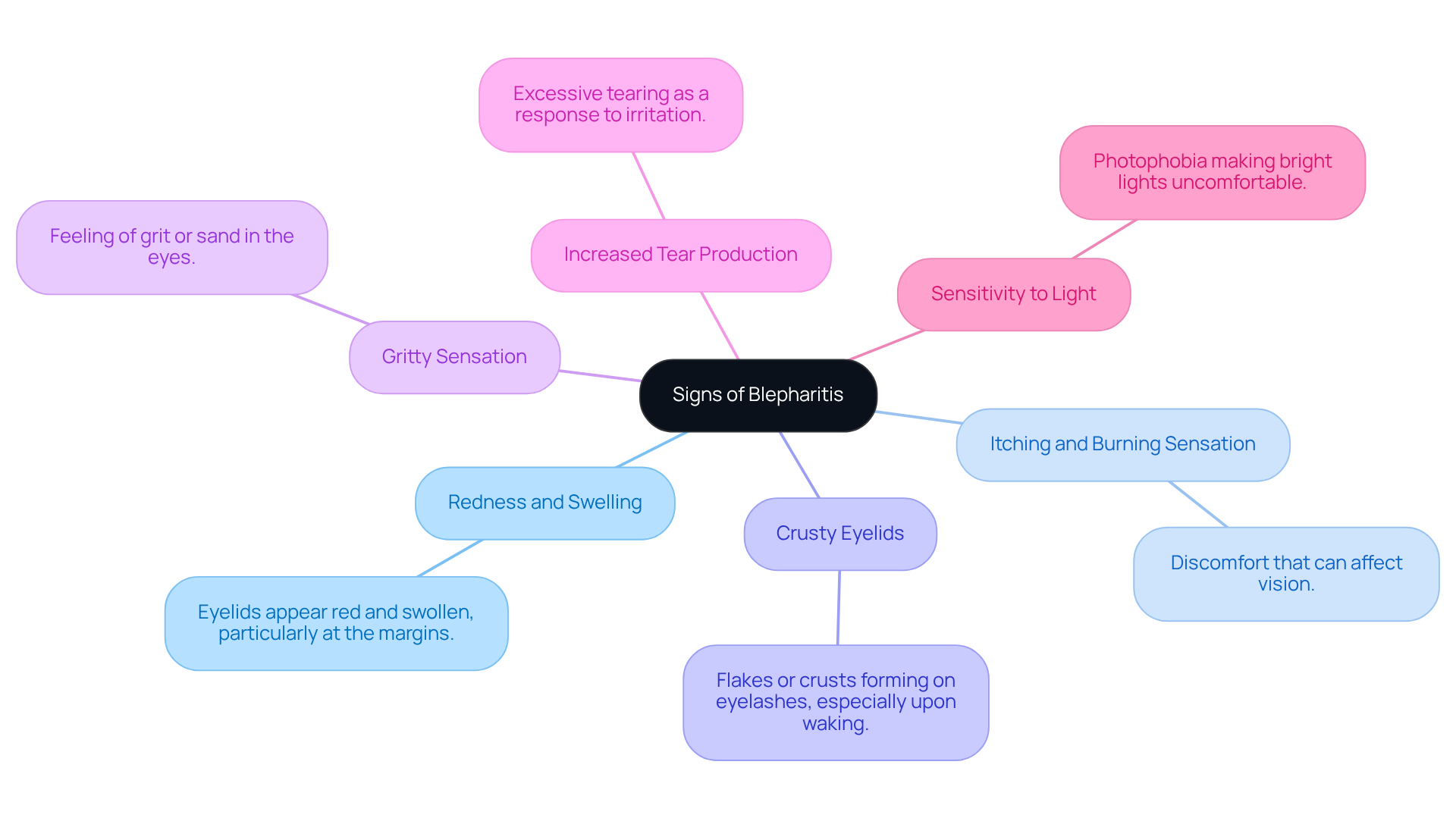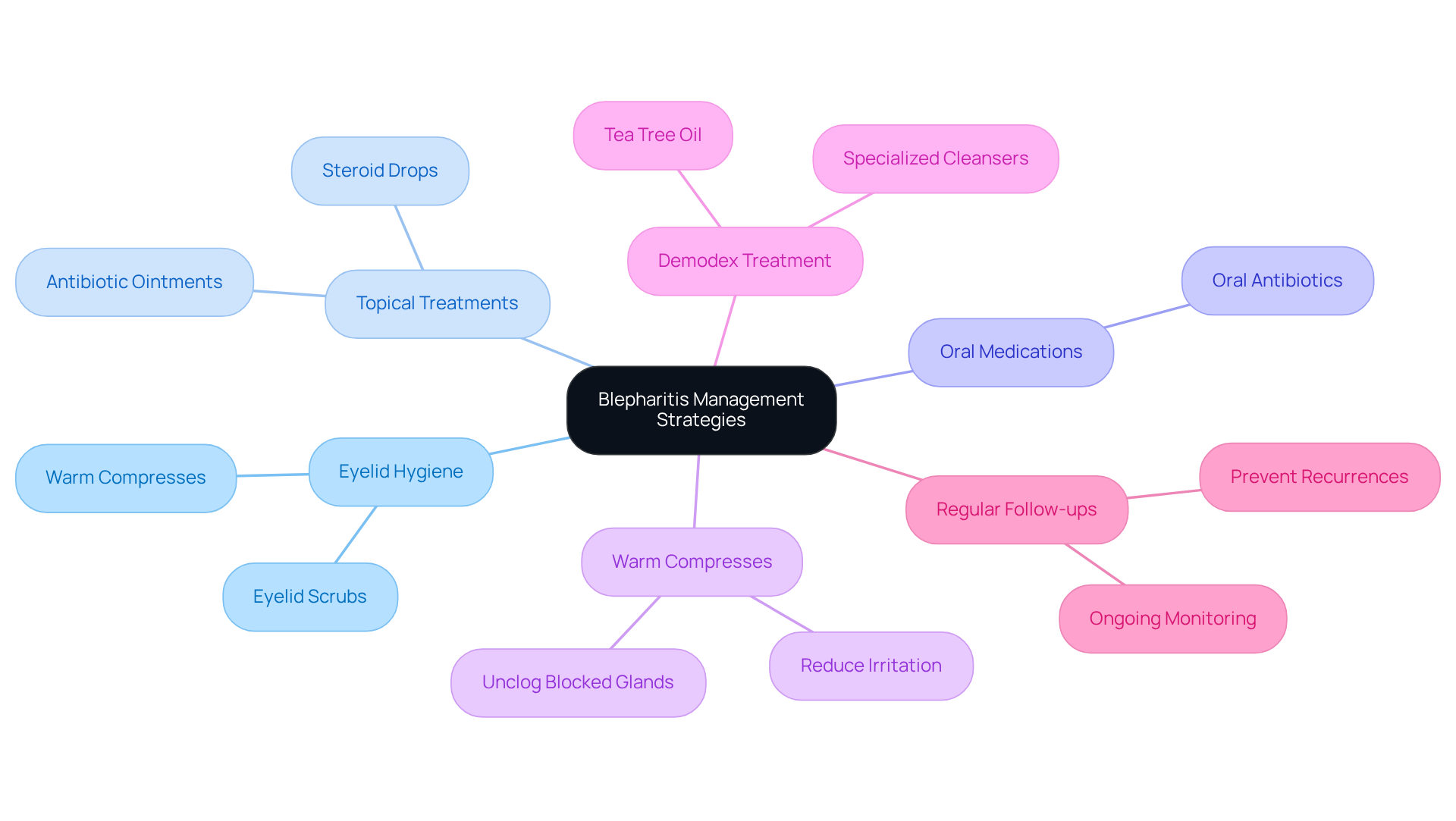Posted by: Northwest Eye in General on October 14, 2025
Overview
Blepharitis is an inflammatory condition that affects the eyelid margins, often causing redness, swelling, and discomfort. We understand that dealing with this condition can be frustrating. There are two main types: anterior and posterior inflammation. It’s essential to recognize the causes, which may include:
- Bacterial infections
- Skin conditions
- Environmental factors
Understanding the symptoms is crucial, and we want you to feel informed and empowered. Effective treatments, such as eyelid hygiene and topical medications, can significantly help manage the condition. By taking these steps, you can improve your overall eye health and comfort. Remember, you are not alone in this journey, and we are here to help you through the process.
Introduction
Blepharitis is an often overlooked yet common inflammatory condition that can pose significant challenges for many individuals. It manifests as redness, swelling, and irritation along the eyelid margins, which can understandably cause discomfort. We recognize that dealing with this condition can be frustrating, and understanding it is crucial. Not only does it affect your comfort, but it can also lead to serious visual disturbances if left untreated.
How can you effectively manage the discomfort and prevent the recurrence of blepharitis while navigating its various causes and symptoms? In this article, we delve into the intricacies of blepharitis, offering insights into its causes, symptoms, and effective treatment strategies. Our goal is to empower you to take control of your eye health and provide you with the reassurance you need during this journey.
Define Blepharitis: Overview and Significance
Blepharitis eye is a common inflammatory condition that affects the eyelid margins, often causing redness, swelling, and irritation. We understand that dealing with this condition can be uncomfortable and concerning. There are two primary types:
- Anterior inflammation, which affects the outer eyelid
- Posterior inflammation, impacting the inner eyelid
It’s essential to comprehend blepharitis eye, as this condition can lead to discomfort and visual disturbances if left untreated. Many patients experience blepharitis eye issues, making it a frequent concern in eye care practices. We are here to help you through this process and ensure you feel supported.
Proper identification and management are vital for maintaining overall eye health and comfort. Remember, can make a significant difference in your experience and recovery.

Identify Causes: Factors Contributing to Blepharitis
Understanding the interrelated factors that can lead to is essential for your comfort and care. We want to help you navigate this condition with compassion and clarity.
- Bacterial Infections: One of the most common causes of blepharitis is an overgrowth of bacteria, especially Staphylococcus species, on the eyelid margins. This bacterial proliferation can destabilize your tear film and lead to inflammation. It’s important to know that studies indicate that blepharitis eye inflammation affects between 37% and 47% of patients treated by eye care specialists in the U.S., highlighting just how prevalent this issue is.
- Skin Conditions: Conditions such as seborrheic dermatitis and rosacea can significantly contribute to eyelid inflammation. If you have seborrheic dermatitis, which impacts areas rich in sebaceous glands, you may notice that it often coexists with inflammation of the eyelids, worsening your symptoms. Additionally, those with rosacea might experience ocular symptoms that complicate managing eyelid inflammation.
- Meibomian Gland Dysfunction: Blocked meibomian glands can disrupt the lipid layer of your tear film, leading to dry eyes and inflammation. This dysfunction is particularly common in older individuals and can exacerbate your symptoms of eyelid inflammation.
- Demodex Mites: These tiny mites, which reside in eyelash follicles, can cause significant inflammation and irritation. Their presence is often associated with chronic eyelid inflammation, making it essential to consider targeted treatments.
- Environmental Factors: Exposure to irritants like smoke, dust, and allergens can worsen the signs of this condition. These environmental triggers can lead to increased inflammation and discomfort, underscoring the importance of managing external factors in your treatment plan.
Grasping these factors is crucial for creating effective treatment approaches and avoiding relapse. Continuous management is required to sustain control over these issues and enhance your quality of life. Eyelid cleanliness is vital for treating the inflammation associated with blepharitis eye, and we encourage you to understand its significance in managing this ongoing condition. Remember, we are here to help you through this process.

Recognize Symptoms: Signs of Blepharitis
Common symptoms of blepharitis can be concerning, and we want to help you understand what to look for:
- Redness and Swelling: Your eyelids may appear red and swollen, particularly at the margins, which can be distressing.
- Itching and Burning Sensation: Many patients describe discomfort, including itching and a burning sensation that can affect your vision.
- Crusty Eyelids: You might notice flakes or crusts forming on your eyelashes, especially upon waking, which can be uncomfortable.
- Gritty Sensation: It’s common to feel a gritty or sandy sensation in your eyes, adding to your discomfort.
- Increased Tear Production: Some individuals experience excessive tearing as a response to irritation, which can be frustrating.
- Sensitivity to Light: Photophobia can occur, making bright lights feel uncomfortable.
Identifying these signs early is crucial for timely care and relief from distress. We understand that experiencing these symptoms can be worrisome. It’s essential to consult a Northwest Eye doctor for an accurate diagnosis and appropriate care. Remember, these symptoms may also indicate that require professional attention, and we are here to help you through this process.

Explore Treatments: Effective Management Strategies for Blepharitis
Managing blepharitis can feel overwhelming, but there are effective strategies that can help you find relief and improve your eye health. We understand that dealing with this condition can be frustrating, so let’s explore some together.
- Eyelid Hygiene: Regularly cleaning your eyelid margins with warm compresses and eyelid scrubs is essential. This practice helps reduce inflammation and removes debris that may be causing irritation.
- Topical Treatments: Your eye care professional may prescribe antibiotic ointments or steroid drops to control bacterial growth and alleviate inflammation. These treatments can provide significant relief.
- Oral Medications: In more severe cases, oral antibiotics might be necessary to tackle persistent infections. It’s important to follow your healthcare provider’s guidance in these situations.
- Warm Compresses: Applying warm compresses can be soothing. This method helps unclog blocked glands, providing comfort and reducing irritation.
- Demodex Treatment: If your blepharitis is caused by Demodex mites, treatments like tea tree oil or specialized cleansers may be recommended. These targeted solutions can make a difference in your recovery.
- Regular Follow-ups: Ongoing monitoring by an eye care professional is crucial. Regular check-ins help manage chronic blepharitis effectively and prevent recurrences.
Implementing these strategies can significantly improve your symptoms. Remember, we are here to help you through this process and enhance your overall eye health.

Conclusion
Blepharitis is a common and often uncomfortable inflammatory condition that affects the eyelid margins. We understand that dealing with this condition can be distressing, which is why recognizing its two main types—anterior and posterior inflammation—is crucial for effective management and maintaining your overall eye health. This condition not only causes physical discomfort but can also lead to visual disturbances if not addressed promptly. By acknowledging the importance of early intervention, you can significantly improve your quality of life.
This article explores the various causes of blepharitis, including:
- Bacterial infections
- Skin conditions
- Meibomian gland dysfunction
- Environmental factors
Each of these elements can worsen symptoms such as redness, itching, and crusty eyelids. It’s essential to implement effective management strategies, ranging from eyelid hygiene to targeted treatments for underlying causes, to alleviate discomfort and prevent recurrence. Regular follow-ups with eye care professionals can ensure you receive ongoing support and tailored care.
In conclusion, understanding blepharitis is vital for anyone experiencing its symptoms. By staying informed about its causes, recognizing the signs early, and implementing effective treatment strategies, you can take control of your eye health. We emphasize the significance of proper eyelid care and encourage you to seek professional guidance, which can lead to improved comfort and overall well-being. Taking proactive steps today can pave the way for healthier eyes and a better quality of life in the future.
Frequently Asked Questions
What is blepharitis?
Blepharitis is a common inflammatory condition that affects the eyelid margins, causing symptoms such as redness, swelling, and irritation.
What are the two primary types of blepharitis?
The two primary types of blepharitis are anterior inflammation, which affects the outer eyelid, and posterior inflammation, which impacts the inner eyelid.
Why is it important to understand blepharitis?
Understanding blepharitis is important because it can lead to discomfort and visual disturbances if left untreated. Proper identification and management are vital for maintaining overall eye health and comfort.
How common is blepharitis among patients?
Blepharitis is a frequent concern in eye care practices, with many patients experiencing issues related to this condition.
What should one do if they suspect they have blepharitis?
It is essential to seek care early if you suspect you have blepharitis, as this can significantly improve your experience and recovery.






